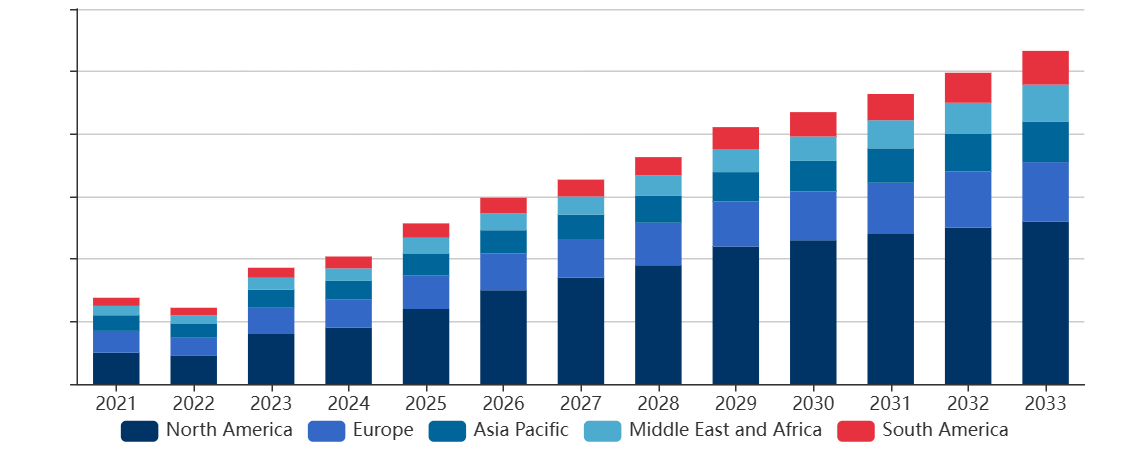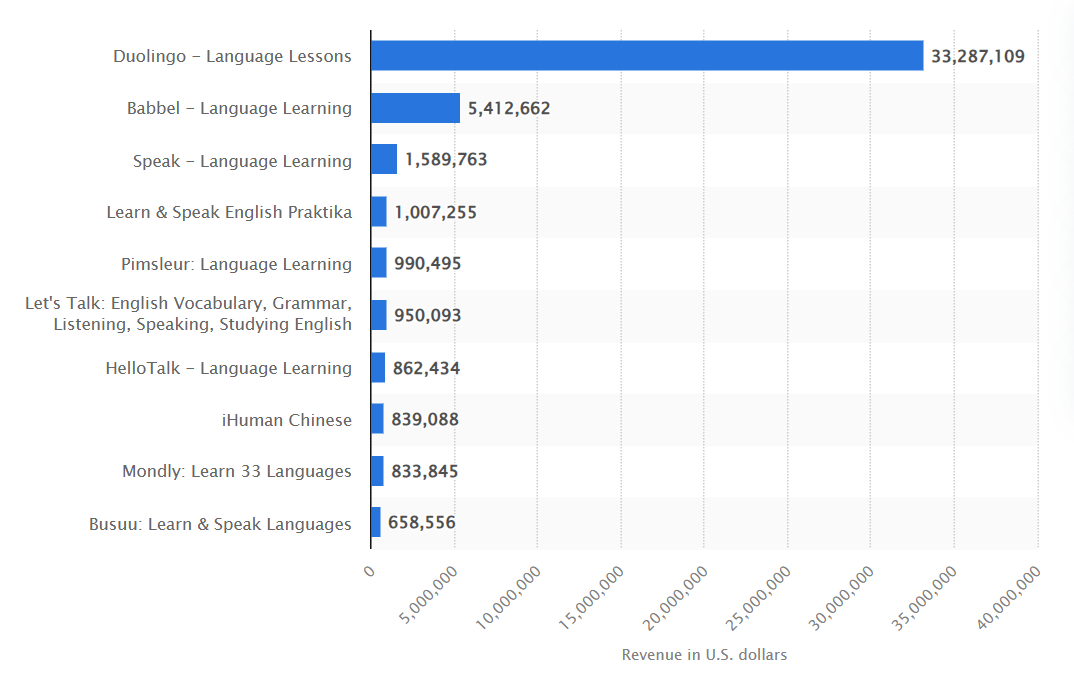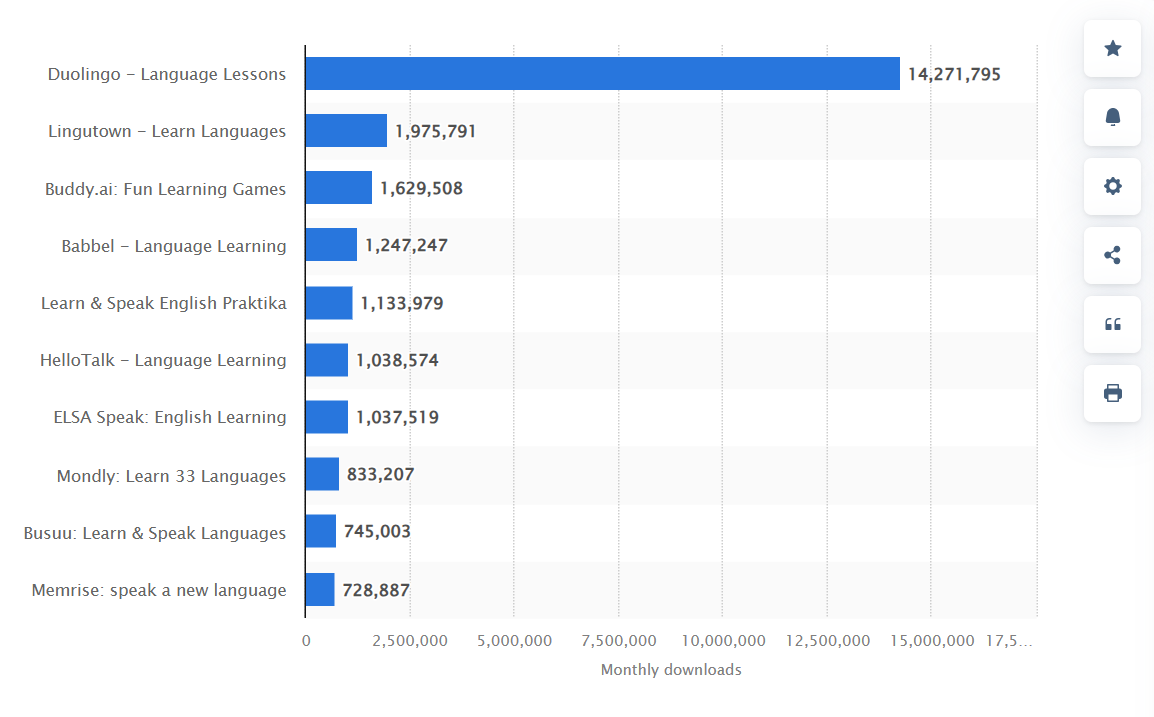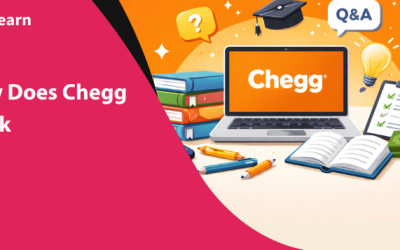Language Learning App Market to Reach $227B by 2035
Language learning is one of the fastest-growing segments of the edtech industry. New platforms like Duolingo, Busuu and Babbel, are re-writing the language learning narrative!
Further, trends like AI, gamification, and NLP are catalyzing the language learning market growth. These language learning apps have revived many lesser-known languages. With the language learning industry size is expected to reach $227 billion by 2035 and the industry is expected to grow more.
On that note, let’s take a look at some interesting statistics of the language learning app industry. We list the growth drivers, challenges, revenue share, and the top players reigning the industry. Further, we also provide the emerging trends and look into the future of the industry.
So, let’s get started on this insightful language learning journey!
Key Language Learning Statistics
The global language learning app market size is $3258.2 million in 2024 and is expected to grow by 17% CAGR from 2024 to 2031. Language learning apps help learners to master new language skills through interactive video lessons, quizzes, exercises, and personalized feedback.
For years, learning a language was sitting through intensive classroom sessions. Flipping through textbooks, memorizing endless vocabulary lists and practicing face-to-face conversations.
Then, language learning apps entered the game. Soon, adaptive algorithms, AI bots, and speech recognition reshaped the language mechanics.
Now, learners can access these language learning apps from any part of the world. They can use smartphones, tablets, and desktops to learn a new language.
Here are some key statistics across the language learning industry:
- There are around 1.5 billion language learners worldwide actively learning a foreign language. (Lingomelo)
- Amongst the 1.5 billion language learners, English is the most widely learnt language. Other in-demand languages are Mandarin, Spanish, and Arabic, which are increasing opportunities in the job market. (Lingmelo)
- North America dominates the language learning industry region-wise. (Meticulous Research)
- In 2025, online courses and apps are expected to dominate the language learning app market based on their offerings. (Meticulous Research)
- Based on the learning mode, one-on-one learning is expected to be the largest growth contributor in 2025. (Meticulous Research)
- Asia-Pacific is the fastest-growing regional market, projected to grow with the highest CAGR. (Meticulous Research)
- Duolingo earned the highest revenue of $748 million in 2024. (BusinessofApps)
Growth Drivers
- Rising global demand for language learning
- More businesses are expanding globally
- Focus on skill development for job growth
- Technological advancements like AI and interactive learning
- Remote work and virtual communication
- Increase in smartphone users in diverse arenas
Challenges
- Increased competition from new industry players
- User engagement and retention
- Technology and Platform Limitations
- Lack of human interaction and feedback
- AI integration challenges
- Cost and scalability
Regional Analysis
- North America holds a 40% revenue share in the language learning market size. The global market size is around $1303.3 million in 2024.
- Europe holds 30% of the market share with $977.5 million.
- While Asia Pacific is in the third position with 23% global revenue, accounting for $749.4 million in 2024.
- Other countries holding a significant share of the market revenue are Latin America, the Middle East and Africa.

Language Learning Methods & Approaches
- Traditional classroom-based learning
- Language learning apps and platforms
- Immersion programs (learners immerse themselves in a country or community where the target language is spoken)
- Language exchange platforms
- Self-study or independent learning
Market Share & Revenue
- Reportedly, the language learning app market generated revenue of $1.08 billion in 2023, an 18% yearly increase. (Business of Apps)
- Duolingo amassed a revenue of $531 million in 2023 and $748 million in 2024. (Business of Apps/Duolingo)
- As of June 2025, Duolingo has around 288,333 downloads. (AltIndex)
- By end-user analysis, the individual learner segment holds 65.2% market share of the language learning industry. (Market.us)
- The self-learning app segment contributed the largest share of 64.2 % in 2024. AI, AR/VR, and machine learning are the major growth drivers of this segment. (Grand View Research)

Key Market Segments
By Type
- Self-paced
- Tutoring Model
By User Demographics
- Age Group
- Gender
- Educational Level
By Learning Goals
- Travel
- Professional development
- Education
- Test preparation (e.g., TOEFL, IELTS)
- Personal Interest
- Business
By Platform
- Mobile
- Web-Based
By Payment
- Free Users
- Freemium
- Subscription
- One-time purchases
By Technology Proficiency
- Beginner
- Intermediate
- Advanced
End User Analysis
- Individual Learner
- Corporate Learner
- Academic Learner
Top Language Learning Apps
The language learning space is competitive with several popular and existing players. Large players dominate the language industry and are gaining the most traction. These leading players are characterized by a massive user base, brand recognition, advanced technology, etc.
Let’s take a closer look at the top language learning apps!
| Language Learning App | Revenue | Features |
| Duolingo | $748 million | One of the popular language learning apps with personalized learning and gamified approach motivating learners. The app includes interactive lessons, quizzes, and exercises. |
| Babbel | $272.9 million | Babbel is a subscription-based language learning platform using the proven Babbel method. It incorporates real-life conversations and focuses on short, interactive lessons. |
| Bussu | $39 million | Largely popular language learning app with over 120 million users across 14 languages. Highly-focused on listening and speaking with speech-recognition. |
| Speak | $15 million | AI-powered language app offering lessons for English, Spanish, French,Italian, etc. It focuses on real conversations, pronunciation and instant feedback. |
| Memrise | $18.5 million | Making it to Google’s App of the Year in 2017, Memrise uses the proven spaced repetition method to master vocabulary. |
| Rosetta Stone | $210.1 million | Known for its immersive learning, Rosetta Stone helps learners through real-world scenarios. From advanced speech recognition to interactive activities, instills confidence in early learners. |
| LingoDeer | $5 million | A beginner-friendly app that helps learners to master languages through dialogue-driven and engaging lessons. |
| Preply | $1.6 billion | Popular language tutoring app offering personalized 1-on-1 lessons over 90 languages. |
| HelloTalk | $8.6 million | Innovative language exchange app for chatting with native language speakers. |
(Source: Statista, BusinessOfApps, ZoomInfo)

App Downloads
Let’s take a closer look at the app download statistics for language learning:
- The language learning app witnessed around 231 million downloads in 2023 recovering from its previous year figures. (Business of Apps)
- In July 2024, Duolingo was the most popular language learning app, with 14.3 million users downloading during the month. (Statista)
- With two million downloads, Lingutown was the second most downloaded language app. Buddy.ai, Babbel, and HelloTalk were the other most downloaded apps. (Statista)
- The global language learning app witnessed two significant peaks of downloads: 26.5 million downloads in August 2024 and 25 million in January 2024.(Market.us)
- In 2021, Europe experienced a peak of 71 million in the Multilingual and Kids categories. (Sensor Tower)
- Individuals around 18-24 showcase around 48% engagement (Market.us)
Here’s a visual representation of the top language learning apps:

Emerging Trends
Here are the top learning trends to watch out for in 2025:
-
Artificial Intelligence Integration
From personalized language lessons to real-time feedback, AI is transforming the language learning industry. It provides benefits to both learners and tutors alike. After learning from human interactions, AI is making learning a convenient experience. Although AI is a powerful tool, it cannot replace the human interactions in learning.
AI has dramatically changed language learning. It adapts to the learner’s shortcomings and offers personalized lesson plans for improvement. This ensures a more engaging and user-centric learning experience.
-
Machine Learning
Machine learning aids language learning through personalized paths and AI-powered bots. Learning paths use machine learning to adapt based on the learner’s pace and performance. Besides, bots can predict learning outcomes and also identify areas of extra support.
Natural language processing is a part of machine learning. Learners can engage with AI-powered conversational agents. These agents involve speech recognition, or real-time feedback on pronunciation or grammar. This sharpens the learning curve and also instills confidence in them.
-
Gamification
Streaks, challenges, rewards, and leaderboards are obsessive. Mastering the dynamics of a language is no longer a chore. It’s fun, engaging, and surprisingly addictive.
Take the case of Duolingo, its in-game mechanics lead to habit formation. Streaks, daily goals, XP and levels, and badges ensure learners are committed to their learning journey.
-
Nano-Learning and Micro-Learning
Research proves that the average attention span of Gen-Z is around 5-10 minutes. Micro-learning involves dividing complex topics into nuggets of information. Bite-sized language lessons are typically around 10-15 minutes and focus on specific topics.
The sizable chunks make it easier to learn new words, phrases and grammar semantics. Further, using visual aids like flashcards, mind maps, and diagrams enhances learning. Short and interactive videos, games, quizzes, and infographics are examples of micro-learning.
-
Technology for Immersive Learning Experiences
Lastly, immersive language learning experiences like virtual reality are a thing. It helps learners to practice language learning in real-world scenarios. Some virtual environments are virtual field trips, professional simulations, etc.
So, this offers an opportunity to chisel learners’ speaking, listening, and writing skills. The basic point is to offer the experience of “being there”. The influence of VR has extended far beyond 2-D experiences to custom avatars and well-rounded 3-D experiences.
Language Learning Funding & Startup
Below are language learning apps to watch out for in 2025:
| Language App | Founding Year | Available on | Funding |
| Mondly | 2013 | Web | Acquired by Pearson on Apr 2022 |
| Speaky | 2014 | Web, iOS,Android | No Funding Rounds |
| Polygot Club | 2014 | Web | $1.8 M |
| Idyoma | 2014 | Web, iOS, Android | $2.5K for last pre-seed round () |
| Tandem | 2014 | Web, iOS, Android | $309 M |
| Lingbe (Acquired by Italki) | 2015 | Web, iOS, Android | $16.3 K |
The Future of Language Learning
The language learning app industry is in for a monumental shift. Moreover, AI is leading language learning to a more personalized approach. Powered by technologies like predictive analytics, machine learning, and NLP, AI is adapting to the nuances of human language.
Language learning apps like Duolingo, Babbel, and Memrise are embracing the personalized approach. As the language learning app market size is poised to evolve, it will become a powerful tool to support the transformative journey of learners!
As we embrace AI, human interaction remains vital for language learning. This creates a superior experience, increasing your learning potential!
FAQ-Related to Language Learning App Market Size
1. What are the statistics for language learning?
The global language learning app market is $3258.2 million in 2024 and is expected to grow to about $16.2 billion by 2033. Duolingo is the most popular language app with 14.3 million downloads in 2024.
2. Is language learning a profitable industry?
Yes, language learning apps are a highly profitable industry. The average revenue is around $4,93,000 per year. In 2024, Duolingo achieved a remarkable revenue of $748 million.
3. How large is the English language learning market?
The global English language learning market was valued at around $28.7 billion in 2024. It is projected to reach $70.7 billion by 2030, with a CAGR of 16.2% from 2024 to 2030. The rising demand for English proficiency, globalization, and technological advancements are potential growth drivers.
4. Which is the no.1 language learning app?
Duolingo is the most popular language learning app, with a revenue of $748 million. Other popular language learning apps are Babbel, Memrise, Busuu, Rosetta Stone, etc.





